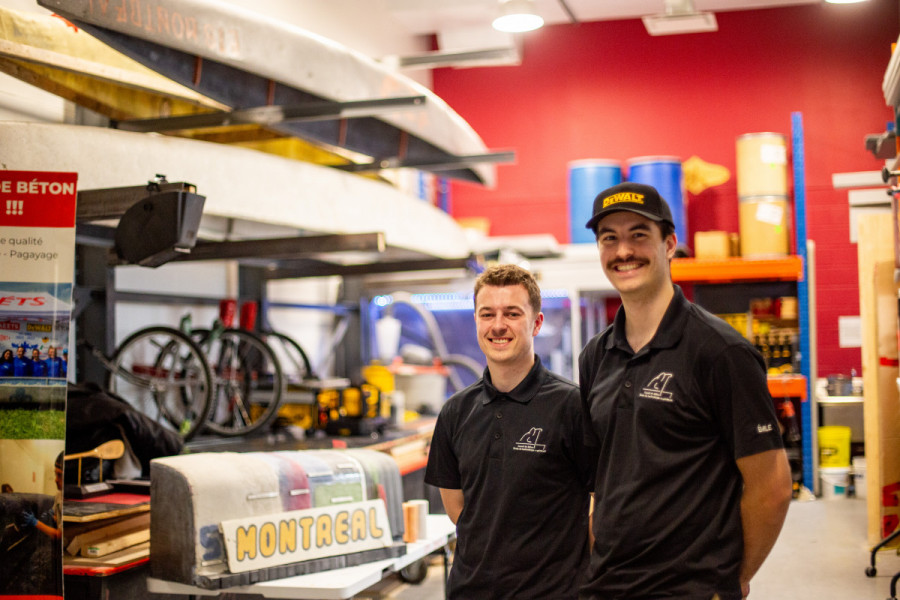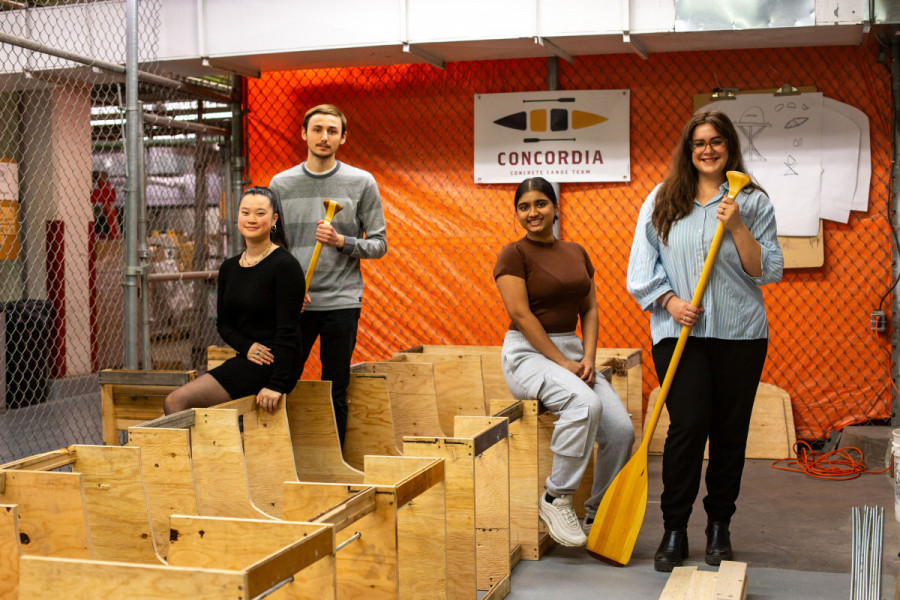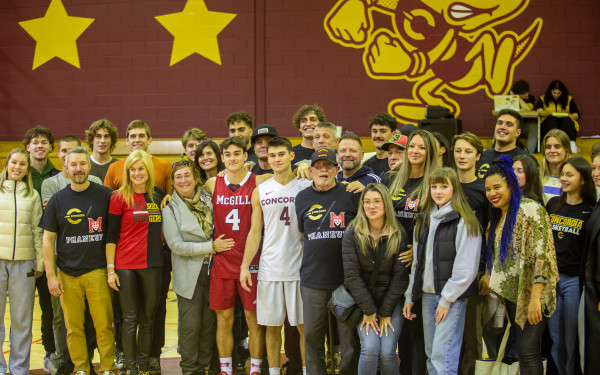The sporty, scientific and ludicrous art of making concrete float
Engineering students prepare for the annual Canadian National Concrete Canoe Competition
“How does it float?” is the first question everyone asks engineering students Alex Schuller, Julien Dyotte and Émile Rochon, when they learn they build concrete canoes competitively.
While the task sounds impossible at first glance, engineering students succeed year after year through their knowledge of concrete and laws of physics. On top of that, they even race their sturdy canoes in the annual Canadian National Concrete Canoe Competition (CNCCC).
The 29th iteration of the CNCCC will be hosted by Université Laval and will pit teams from 19 Canadian universities against one another. The competition evaluates concrete canoe teams on a technical report, an oral presentation, the overall aesthetic of the canoe, as well as racing capabilities.
“There are men’s and women’s sprints, a three-person perimetre circuit, and a co-ed with two women and two men where they need to accomplish two loops of the circuit,” said Marie-Laure Filion, the co-Chair of the student competition committee at the CNCCC and a former captain at Université Laval.
She added that before the races, teams need to accomplish a buoyancy test. As Filion explained, “The first day [of the competition], we take the canoes, we submerge them underwater and they have to float back to the surface. They float because they have a density inferior to that of water. Therefore, you want the concrete to be ultra light.”

Indeed, the secret to making concrete canoes float lies in the concrete mix itself. Dyotte and Rochon are construction engineering students and the co-captains of the École de technologie supérieure (ETS). They explained that the concrete they use for the canoes is different from the concrete used in construction around the city.
“What makes concrete float [...] is the aggregates we put in [the concrete],” said Rochon. “In regular concrete, we use MG-20, which is basically rocks, and with our concrete, we use what we call PORAVER.”
“[PORAVER] is expanded glass beads and those are lightweight aggregates,” added Dyotte. The expanded glass itself floats, while MG-20 gravel does not.
ETS, an established concrete canoe team, often makes the podium at the CNCCC. Every year, ETS also participates in the American iteration of the Canadian competition, called the American Society of Civil Engineers (ASCE) Civil Engineering Student Championships.
The ASCE is held a month after its Canadian counterpart, but both are similar.
“Usually, the Americans will release their rule sets first and the Canadians will put theirs out two to three weeks later,” said Filion. “The Canadians always ensure that teams can participate in both competitions with the same canoe, while also giving them some slight obstacles like changing their technical report or the presentation.”
It’s Rochon and Dyotte’s third year with the team. While they are both co-captains, Rochon takes care of the administrative part, and Dyotte is more in charge of the technical side. For them, it was important to join a club to enhance their academic careers.
“The goal is to do something else than just school,” said Rochon “Always being in class is alienating. I love school, but it can be repetitive.”
For Dyotte, he had heard of concrete canoeing in CEGEP and it piqued his interest. From the moment he joined, he quickly got involved in all aspects of construction.
“The other [ETS] clubs interested me, but building a concrete canoe is a project that at first glance feels unreachable. It’s concrete, it shouldn’t float,” he said.
This year also marks the first time the Concordia concrete canoe team will compete physically at the CNCCC since 2017. Team captain and second-year civil engineering student Schuller took on the task of reviving the team.
“When I was looking up Concordia—back when I was trying to sign up for university—I saw that the team sort of existed,” said Schuller. “When I actually enrolled, it was disappointing to see that the team dissolved. So I made it my goal to try to bring it back again.”
In its history, Concordia’s concrete canoe team has competed a total of three times. In 2016 and 2017, the team built a canoe, but, in 2017, the canoe broke during transit. Their third competition was held online in 2021 and only consisted of theoretical work due to the COVID-19 pandemic. For Schuller, building the team back up has been challenging, yet rewarding.
“Some of us (team members) had internships in the fall so we were actually completely virtual from September to December,” said Schuller. “I'm happy that's the way it turned out because we had a lot of digging to do and a lot of reading on like past documents going through what the other teams have done.”
Schuller compared her research and her work to an archaeological dig to find any information about previous Concordia teams, contacting past members and captains. This inspired the theme for their canoe this year: Shipwreck.
“We're playing off the fact that the previous canoe had broken and we also feel like we're underwater archaeologists trying to find clues about what past teams have done,” Schuller said.
The Concordia concrete canoe team has currently set up their workshop in the basement of the Hall building, where they are surrounded by other engineering clubs. When The Link met with Schuller, June Aldinucci, vice president of marketing and paddling coordinator, was working on a training program for the paddlers who will race during the competition.
“We're going to try to go [to Le Gym] once a week and I’m also talking to a place called Canal Fitness,” said Aldinucci. “They have these boat simulators. It might be fun [...] so the people who have never paddled before have a feeling of how heavy water is.”
Schuller noted the enthusiasm of her team. Both her and Aldinucci said that they aim to create a foundation for future Concordia teams.
“We're saying to the team that this year we're putting in a lot of work so that the next year is a little bit easier for them; laying out the procedures,” said Aldinucci. Schuller added that their goal this year is to “literally get in the water.”
“A lot of universities do the concrete canoe competition, and I feel like it's time that Concordia is represented in those competitions among the other prestigious schools,” said Schuller. “I feel like we deserve to be there and we can prove that we can get there.”
This article originally appeared in Volume 44, Issue 12, published March 19, 2024.


_600_832_s.png)

_600_375_90_s_c1.jpg)


4_600_375_90_s_c1.jpg)